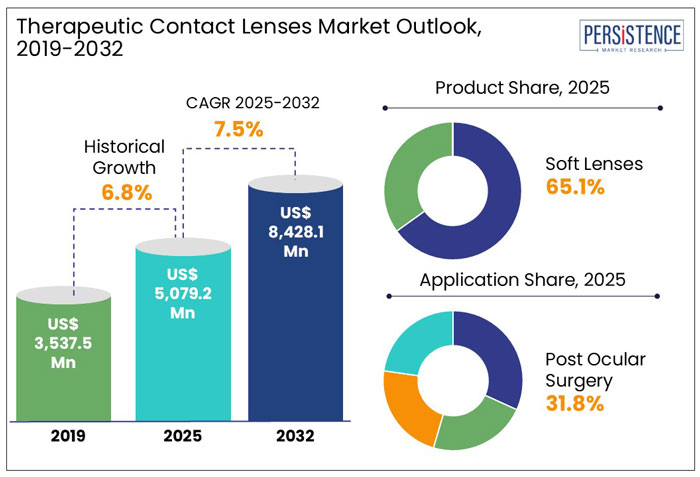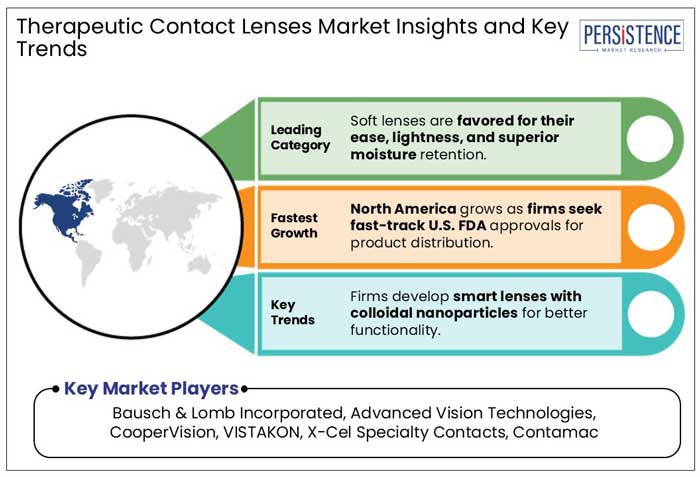Therapeutic Contact Lenses Market
Industry: Healthcare
Published Date: March-2025
Format: PPT*, PDF, EXCEL
Delivery Timelines: Contact Sales
Number of Pages: 194
Report ID: PMRREP35174
The global therapeutic contact lenses market size is anticipated to reach a value of US$ 5,079.2 Mn in 2025 and is set to showcase a CAGR of 7.5% from 2025 to 2032. The market will likely attain a value of US$ 8,428.1 Mn in 2032.
Administering eye medications has always been a daunting task in the field of medicine. A substantial number of commercial eye drops have significant drawbacks because of their rapid clearance mechanisms and ocular barriers. The use of contact lenses as a means of delivering medication is emerging as a promising way to bypass this restriction.
As they are capable of increasing ocular bioavailability and patient compliance while posing few risks, therapeutic contact lenses for the delivery of ocular medications have created a lot of interest. To achieve favorable in vitro and in vivo results with regard to a prolonged drug delivery profile from impregnated contact lenses, it is important to maintain key characteristics like water content, optical transparency, and modulus.
The commercialization potential of pharmaceutical-loaded lenses may be limited by the alteration of lens physico-chemical properties brought on by therapeutic components, in addition to challenges such as burst release and drug stability. To improve the effectiveness of drug-eluting contact lenses, research has advanced toward smart materials and bioinspired techniques.

Key Highlights of the Therapeutic Contact Lenses Industry
|
Global Market Attributes |
Key Insights |
|
Market Size (2025E) |
US$ 5,079.2 Mn |
|
Market Value Forecast (2032F) |
US$ 8,428.1 Mn |
|
Projected Growth (CAGR 2025 to 2032) |
7.5% |
|
Historical Market Growth (CAGR 2019 to 2024) |
6.8% |
Mergers and Acquisitions and Emergence of Smart Contact Lenses Helped the Market to Surge in Historical Period
As per Persistence Market Research, in the historical period from 2019 to 2024, the global therapeutic contact lenses industry witnessed a steady CAGR of around 6.8%. Mergers and acquisitions as well as innovations played an important role in the development of the industry during this period. Companies focused on extending their market presence and improving their technological capabilities through these strategies.
CooperVision, Inc., for instance, completed the acquisition of SynergEyes, Inc. in January 2023. The company finalized the deal that first commenced in November 2022. The acquisition helped improve the former’s product lines by integrating the latter’s specialty contact lenses like proprietary hybrid lenses. The move also complemented CooperVision’s existing range of Onefit scleral lenses, enabling the firm to broaden its portfolio for the treatment of irregular corneas and keratoconus.
Similarly, in June 2024, researchers in Nanyang Technological University's School of Electrical and Electronic Engineering developed an ultra-thin battery that can be embedded into contact lenses. The battery is around 0.2-millimeter thick, and it can be charged by the user’s tears.
Researchers were inspired by a scene from ‘Mission Impossible’ to create the smart lenses. They aim to lower the cost of the battery once it is commercially available. Such innovations in the historical period spurred the global market.
Forecast Period to See Rising Use of Therapeutic Lenses as a Splint for Corneal Lacerations and Perforations
From 2025 to 2032, the therapeutic contact lenses industry is likely to showcase a considerable CAGR of 7.5%. Therapeutic contact lenses are set to be used as a splint for corneal lacerations and perforations. These are projected to be highly effective in sealing small lacerations and perforations with or without adhesives.
A study conducted by the Singapore National Eye Center revealed that silicone hydrogel lenses were effective in corneal wound sealing applications, mainly in corneal perforations <2 mm in diameter. Therapeutic lenses and fibrin glue were also used even in larger corneal perforations as a temporary measure before initiating keratoplasty. The market is projected to see research institutions and lens companies conducting in-depth studies in the future to come up with new products.
Increasing Demand for Pain Management Solutions to Propel Adoption of Therapeutic Contact Lenses
Therapeutic or bandage contact lenses are set to be considered a significant tool for treating corneal conditions like ocular surface disease. This is attributed to their ability to counter the abrasive effects of the patient’s eyelids and protect the cornea from environmental factors. These lenses can help maintain visual acuity, manage pain, and repair tissue.
Filamentary keratitis, bullous keratopathy, and corneal erosion often lead to intense pain. The use of soft therapeutic lenses is anticipated to offer measurable relief to those experiencing these conditions. After cataract surgery, these lenses can temporarily tamponade leaking wounds.
With or without the application of an adhesive, the lenses can also be useful in reshaping the anterior chamber for small perforations. Hence, rising demand for pain management solutions among patients suffering from certain ocular conditions is projected to boost the market.
Dehydrated Therapeutic Lenses May Lead to Warping and Infection Risks, Impacting Patient Comfort
Depending on the condition, a therapeutic lens is usually fitted to be worn both during the day and at night. There is a significant risk of acquiring infectious keratitis with continuous wear. However, using these lenses is considered only temporary for certain conditions. Healthcare professionals often prescribe daily disposable contact lenses if a condition necessitates wearing lenses for an extended period.
Soft lenses with high to moderate water content have been mainly used as bandage lenses post refractive surgery due to their high Dk and comfort. High water content, however, can make these lenses prone to drying. Dehydrated lenses can become warped and accumulate deposits, which can lower patient comfort and raise the risk of infection. Corneal desiccation and staining may occur as the lens draw water from the ocular surface for hydration.
Key Companies to Use Colloidal Nanoparticles to Improve Performance of Therapeutic Contact Lenses
Leading companies are likely to use colloidal nanoparticles in ocular delivery as these help support extended drug stays on the cornea. When put into a contact lens matrix, nanoparticles create a drug delivery system that is more durable than the lens or the nanoparticles alone.
To reach the contact lens matrix, the medication is transported by nanoparticles in the delivery mechanism. It then passes through the hydrogel matrix and into the tissues of the eyes. Companies have already started incorporating several forms of nanoparticles like emulsions, polymeric nanoparticles, micelles, and liposomes into therapeutic contact lenses to improve their effectiveness.
Soft Lenses to be Highly Preferred for Managing Conditions like Keratoconus due to Ease of Use
In the global therapeutic contact lenses industry, the soft lenses segment is projected to hold a share of 65.1% in 2025 backed by their ease of use, versatility, and comfort. Therapeutic soft contact lenses are also preferred due to their adaptability and lightweight nature. Such beneficial properties make these ideal for several therapeutic applications, including the management of keratoconus and dry eye syndrome.
Their popularity is further anticipated to rise because of innovations in technology and materials, improving moisture retention and oxygen permeability. Increasing consumer demand for specialized lenses and rising awareness of eye health are likely to boost the segment in the foreseeable future.
Rigid lenses, on the other hand, are estimated to hold a considerable share of the global market in 2025. These lenses are primarily used for optical and therapeutic indications. These are considered the only optically beneficial lenses for corneal abnormalities that result in a high level of irregular astigmatism.
Therapeutic Lenses to be Used to Quicken Healing Post Ocular Surgeries Like Cataract
By application, the post ocular surgery segment will likely generate a therapeutic contact lenses market share of 31.8% in 2025. These lenses play an important role in improving visual outcomes and promoting healing after surgeries like LASIK and cataract.
The lenses help accelerate recovery time of the corneal surface by lowering discomfort. Increasing focus of healthcare professionals on enhancing patient outcomes and care is anticipated to propel the significance of post-ocular surgery lenses in the global market.
The drug delivery segment, on the other hand, is projected to witness a steady CAGR through 2032. Constant developments in drug-infused lenses are set to create new opportunities in this segment.
A recent study published in the National Library of Medicine, for example, found that a prototype contact lens consisting of a thin drug-PLGA (poly[lactic-co-glycolic acid]) film coated with pHEMA (poly[hydroxyethyl methacrylate]) can be used as a base for ocular drug delivery with increasing therapeutic applications. Similar research studies worldwide have found positive outcomes of drug-eluting contact lenses, thereby propelling the segment.

U.S.-based Manufacturers to Focus on Obtaining Fast Track Approval from FDA for Product Distribution
North America is anticipated to generate a significant share of around 43.7% in 2025. The region’s stringent quality assurance norms, especially for ophthalmic devices, arises from its well-developed healthcare infrastructure.
In North America, the U.S. therapeutic contact lenses market is projected to remain at the forefront. It is attributed to increasing efforts by manufacturers to bag approvals from the U.S. Food and Drug Administration (FDA) for their new products.
Florida-based Johnson & Johnson Vision, for example, obtained FDA approval for its extended line of ACUVUE® Abiliti™ Overnight Therapeutic Lenses for Myopia Management in 2022. Similar fast-track approvals by the FDA are anticipated to open the door to opportunities in the U.S. through 2032.
Innovations in Silicone Hydrogel Materials and Hybrid Lenses to Create Opportunities in Asia Pacific
Increasing prevalence of eye disorders like corneal irregularities, dry eye syndrome, and post-surgical complications is projected to create a high demand for therapeutic contact lenses in Asia Pacific for better management. Innovations in hybrid lenses and silicone hydrogel materials are further anticipated to propel the regional market.
As per studies, nearly 22% of individuals in Japan suffer from dry eye syndrome. This is projected to fuel the need for therapeutic lenses with moisture-retaining properties. Key companies in the country are set to focus on the development of hybrid and scleral lenses for post-LASIK and keratoconus patients.
In China, the government has implemented various policies to address the vision crisis. Under its ‘Healthy China 2030’ initiative, the government provides subsidies for vision correction treatments. The China Food and Drug Administration (CFDA) has also put forward strict norms for contact lens brands.
Certifications and clinical trials are a must before lenses are sold in the market. It has further resulted in rising domestic production of therapeutic lenses by certified manufacturers. At the same time, it has encouraged partnerships between local and international manufacturers to help comply with the norms.
Strong Reimbursement System in Germany to Improve Accessibility to Therapeutic Contact Lenses
In Europe, Germany is considered to house one of the most prominent eye care industries. The country benefits from a strong reimbursement system. Medically critical contact lenses, such as scleral and bandage lenses for corneal abnormalities or post-operative recovery, are partially or completely covered under Germany's statutory health insurance (Gesetzliche Krankenversicherung, GKV). It has enhanced accessibility among patients suffering from complex ocular disorders.
The U.K. therapeutic contact lenses industry, on the other hand, is projected to witness a decent CAGR through 2032. The country is anticipated to be a leading ophthalmic research hub with various research institutes and universities working on next-generation therapeutic contact lenses. Researchers at Aston University and the University of Cambridge, for instance, are working on discovering drug-infused contact lenses to manage conditions like corneal inflammation and glaucoma. These initiatives are set to pave the way for success in the U.K. in the next ten years.
The global market for therapeutic contact lenses is still at the nascent stage. The market houses several large-scale companies who are focusing on investing huge sums in research and development activities to introduce new lenses with unique features. Various academic and research institutions are also aiming to conduct in-depth studies on newly developed lenses with drug-eluting, UV protection, and other features to find out their efficacy.
|
Report Attributes |
Details |
|
Historical Data/Actuals |
2019 - 2024 |
|
Forecast Period |
2025 - 2032 |
|
Market Analysis Units |
Value: US$ Bn/Mn, Volume: As applicable |
|
Geographical Coverage |
|
|
Segmental Coverage |
|
|
Competitive Analysis |
|
|
Report Highlights |
|
|
Customization and Pricing |
Available upon request |
By Product
By Application
By Distribution Channel
By Region
To know more about delivery timeline for this report Contact Sales

The market is set to reach US$ 5,079.2 Mn in 2025.
The industry will likely be valued at US$ 8,428.1 Mn in 2032.
The industry is set to surge at a CAGR of 7.5% through 2032.
Bausch & Lomb Incorporated, Advanced Vision Technologies, and CooperVision are a few key players.
Soft lenses are anticipated to lead the market in 2025.